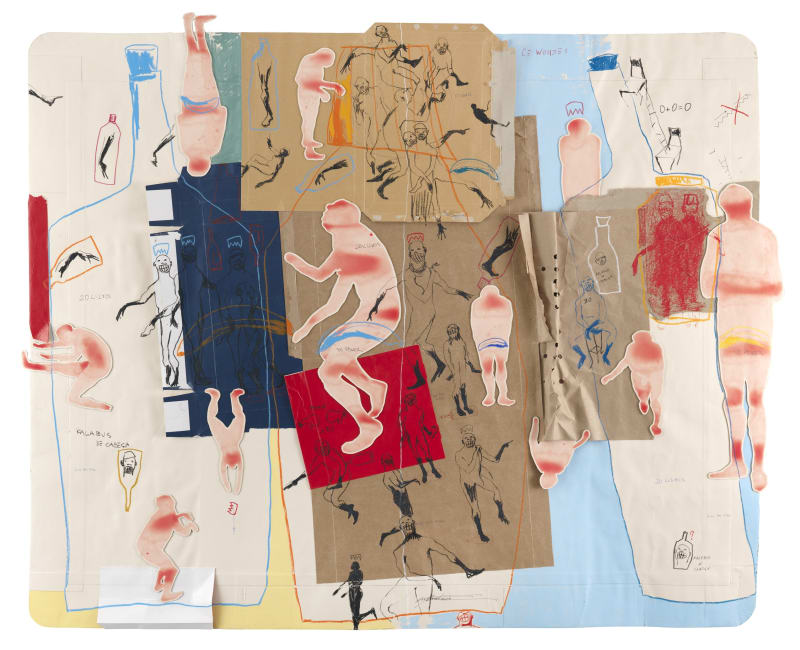Galerie Nathalie Obadia is pleased to present Sensibilité, Nú Barreto's fifth solo exhibition, showcased across both our Paris and Brussels galleries.
Originally from São Domingos in Guinea-Bissau, Nú Barreto is described by art critic Philippe Dagen in Le Monde as one of those artists who 'know how to embed contemporary reality in a singular, clearly symbolic form.' Ever since he was a child, drawing has been his medium of choice for all his expressions: Nú Barreto conveys his sensitive vision through a resolutely personal graphic repertoire. The exhibition features both earlier and recent works on paper, including drawings and collages, as well as a monumental flag titled Transmissions (2022). This work is a continuation of the États-Désunis d'Afrique series, which the artist began in 2009, featuring the American flag with its colours replaced by those of the majority of African states. Traços Diário 1 (2020), a polyptych of 42 drawings conceived as a logbook during the pandemic, also forms part of this selection.
Throughout the body of works on paper human silhouettes, animals, fruit, and other objects are either sketched or cut out of the very material. To create his works, Nú Barreto uses raw, inexpensive materials such as fabric scraps, torn packaging, cardboard, and other recycled paper from supermarket pallets. Their anarchic patchwork-like arrangements embody a certain disorder: firstly, in the composition-where characters traverse the space 'without top or bottom'-and secondly, in a broader reflection of the world's disorder. In these dreamlike, fantastical worlds lie concealed the artist's 'dreams of reason.' Reality prevails in these works, and Nú Barreto manipulates it with great sensitivity. He deliberately creates a 'disruption of drawing', where humour, irony, and even burlesque underscore and denounce the instability of today's world.
The fantasies suggested by the forms do not diminish the artist's awareness of the violence and disturbances of the third millennium. Through his drawings, Nú Barreto does not contradict reality; rather, he adds new nuances based on a lucid and sensitive vision of the world. While the motif of the three-legged chair symbolises the chronic instability of the state of the world, the broken bars represent the dysfunctional social mobility system, contributing to growing inequality. The human form recurs throughout the works as an obsessive figure, reflecting a deep questioning of the self and the other in relation to the world. The bodies of each figure are depicted in constant motion-bouncing, falling, embracing, or fleeing from imminent danger. In his most recent works, such as Testemunho (2022) and Ami (2023), the figures sometimes seem to emerge from the frame or advance toward us with a palpable sense of depth. In this face-to-face encounter, visitors experience the materiality as they observe the variations in scale and volume of the depicted bodies.
This dramaturgy of postures may echo those seen in the works of Francisco de Goya, particularly in Les Désastres de la guerre, a series of engravings created between 1810 and 1815. André Malraux, the former French Minister of Cultural Affairs, declared that the genius of the Spanish painter did not lie 'in abandoning the desire for harmony and embracing horror, but in responding to the irremediable through artistic creation, much as the great religious styles had done, without recourse to transcendence.' Nú Barreto, in turn, captures the human condition in his works; the crisis of the individual that Europe experienced at the end of the 18th century seems as profound as the one the world faces today.
The exhibition Sensibilité brings together a range of works with powerful symbolic resonance, both in their iconography and their colour palette. The characters and other objects, sometimes drawn, cut out, and arranged throughout the works, silently convey messages to us; a silence that screams up to the eyes.
----------
1 André Malraux, Goya, Gallimard, 1978
"Approaching the content of my creations requires a dose of sensitivity and accuracy. An ideology rooted in the perception inspired by society. Content that is Recovered, Recycled, and Restored (RRR). This is a perspective of a testimony illustrating the actions and behaviors on which human beings base their criteria for life and existence. The idea proposed in these works demonstrates how I use sensitivity and lightness on subjects often difficult to address, imposing what is appropriate to say, a personal touch. A well-thought- out practice. The precious presence of red and black, questioning their utility, remains a constant practice in my expression, using signs or symbols that facilitate the understanding of the pictorial gesture. Indeed, it is easier, more subtle, and complete, despite the complexity of the graphic elaboration that envelops morphology, volumes, perspectives, forms, and the color palette. Considering sensitivity as an instrument through which everything must be conveyed, it should be taken into account, especially in Art, as a vector through which artistic communication will make sense in its instructive scope. Sensitivity takes flight in a benevolent manner, allowing the tragic to be understood without tragedy. This is a duty and an exercise in reconciling horizons and ideologies".
Nú Barreto

